If you buy through our links, we may earn an affiliate commission. This supports our mission to get more people active and outside.Learn about Outside Online's affiliate link policy
Smartwatch Reviews From a Triathlete's Perspective
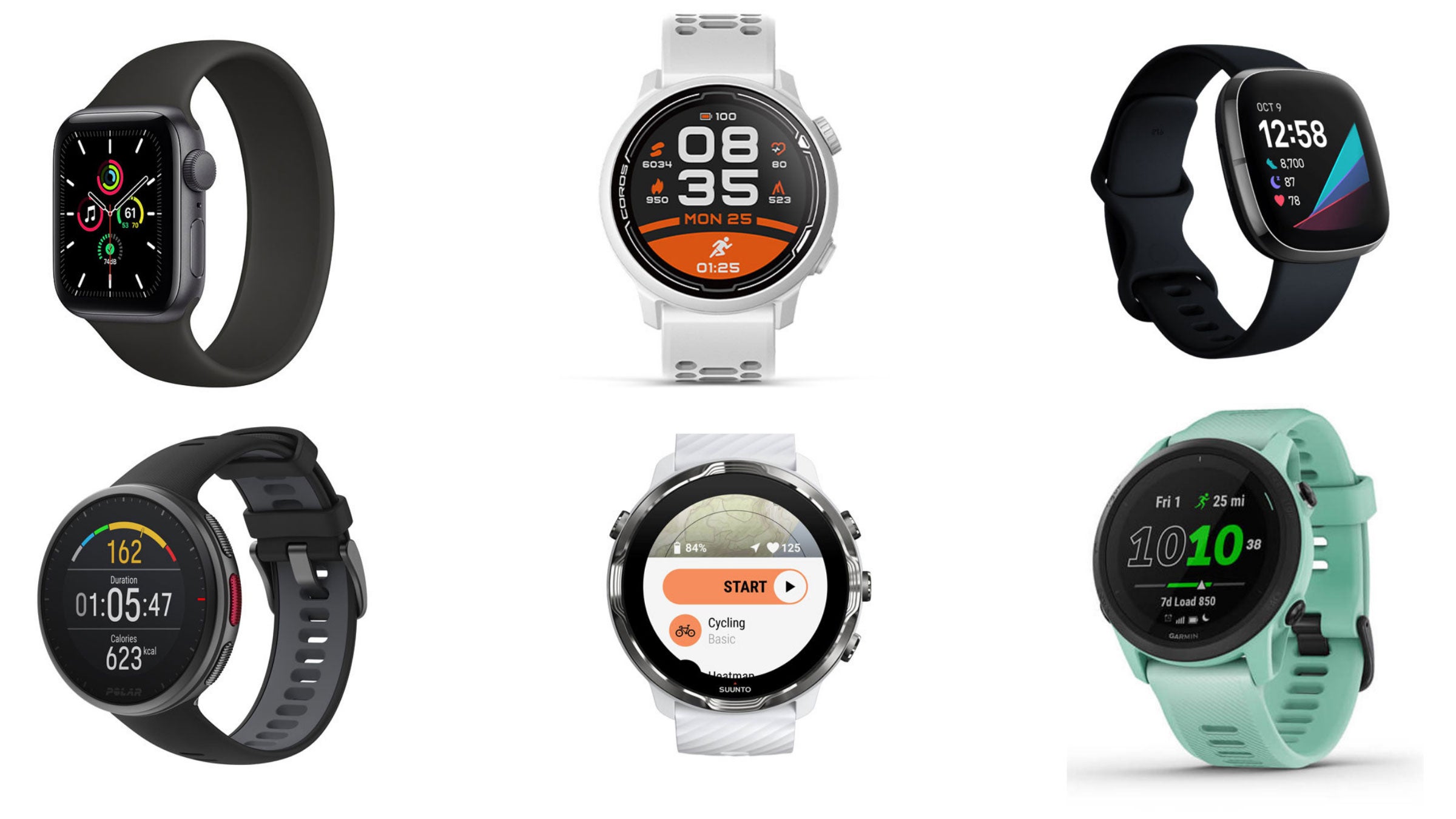
Though smartwatches were doing well before the pandemic, the need for a safe training partner you wear on your wrist has made a smartwatch pretty much essential for tri or run training. Even models that cost a few hundred dollars can do wrist-based heart rate, have decent GPS, support swimming (open water and pool), biking (with advanced device compatibility), and running (with dynamics). With these smartwatch reviews for athletes, we’ll look at a few more lifestyle-focused models that integrate more closely with your smartphone to focus on things like daily tasks, listening to music, sleep tracking, and overall sports. In the lifestyle watches, we’ll be reviewing them through a triathlete’s lens who might be looking for a watch that’s good enough to help with daily life tasks and still handle workouts reasonably well. We’ll also be looking at more training-focused watches that may look and feel more like a workout tool than something that’ll be ideal for answering texts or emails or keeping track of everyday life stuff. We’ll give more weight to those that work better for a triathlete’s needs, but it’s also important to know if any lifestyle watches could work for you too.
Below is the criteria we use in these smartwatch reviews:
Connection – Here we rate how well the watch holds and then regains a connection to a paired smartphone when the connection is broken. Points are deducted when the watch’s app must be opened to reconnect the watch after a break in pairing.
Battery Life – Here we simply look at how well the watch stacks up with a standard amount of triathlete daily use and working out—assuming one to two sessions per day, five to seven days per week.
Data Depth – This rating looks at the depth of data analysis available both during the workout and after. We assume wearers would want to use both the on-watch analysis and looking at files on a smartphone app.
Multisport Capabilities – Simply put, this rating analyzes if the smartwatch has the appropriate sport profiles to accommodate a triathlete’s training. Here we look for pool and open-water swimming, indoor and outdoor cycling, and running (treadmill, road, and/or track mode); we also look for triathlon mode that switches between sports with transitions during a race and/or some sort of multisport mode that would work with brick training or Swimrun events.
Accuracy – Here we rate how accurate the watch’s GPS and onboard heart-rate system is.
Lifestyle Functions – This rating explores how well the smartwatch makes everyday life easier—ignoring any workout or tri-specific features.
Note: While the smartwatches were loaned out by the brands represented, all models were selected independently by the tester without any promotional consideration or brand input.
Smartwatch Reviews for Triathletes
COROS Pace 2
$200, 29g (nylon band), 30 hours training w/GPS, 20 days smartwatch, 42 × 42 × 11.7mm
coros.com

Data Depth – 4/5
Multisport Capabilities – 5/5
Connection – 4/5
Battery Life – 4/5
Accuracy – 4/5 (GPS), 4/5 (HR)
Lifestyle Capabilities – 2/5
If you haven’t heard of COROS yet, it’s time to learn. This is the lightest weight smartwatch on the market, with literally everything a triathlete needs to do 90% of his or her training, fantastic battery life, and rock-solid connections, setup, and data depth. It also has some pretty big features like consistent on-wrist running with power, track running mode, open water, a “muscle heatmap,” and other strength-training/workout capabilities.
The only slight downside you’ll see with the Pace 2 is its lifestyle functions. While it does do one-way smartphone notifications (actually quite well), it’s missing some of the fancy apps and music functions—music control or onboard—that other watches do have. It’s also not going to win any style awards with its Star Trek looks anytime soon.
The big good news on this front is that the Pace 2 is built to expand, and COROS has left a ton of space and processing power for big firmware updates. And if you think that’s nothing but marketing speak for things that’ll never happen—owners of the original Pace recently found themselves with a smartwatch that had onboard running power, despite the fact that it wasn’t an originally advertised feature. Though it might not be the best business practice (think: Apple), COROS has proven that they will support and even make huge software updates on even their older, legacy products.
Read Full COROS Pace 2 Smartwatch Review Here *This review is exclusive for Active Pass Members*
Apple Watch SE
Starting at $280 (all specs 40mm version), 45g, 6 hours training w/GPS, 18 hours smartwatch, 40 x 34 x 10mm
amazon.com
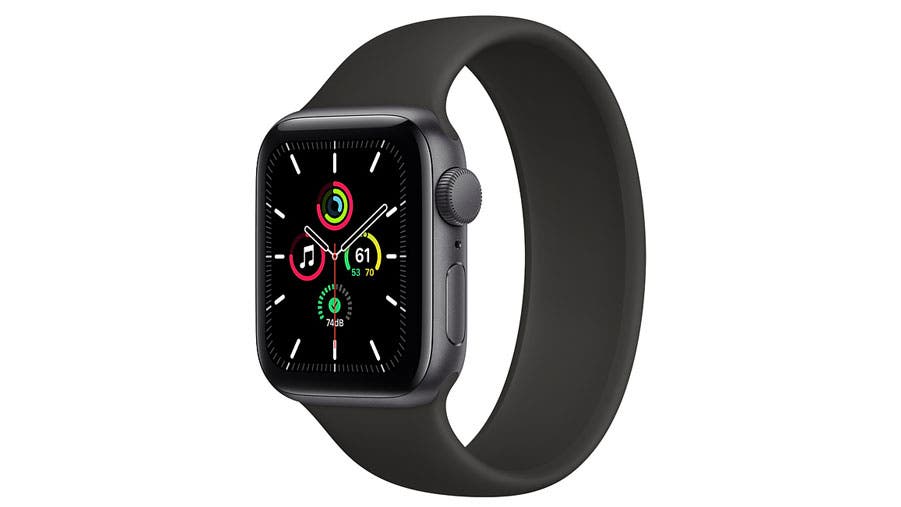
Data Depth – 2/5
Multisport Capabilities – 2/5
Connection – 5/5
Battery Life – 1/5
Accuracy – 2/5 (GPS), 3/5 (HR)
Lifestyle Capabilities – 5/5
No one would be surprised to read that the new Apple Watch SE certainly isn’t a performance-level training watch. However, it does fall in the “make due” category because it does have built-in open-water swimming support that’s not terrible (no triathlon/multisport modes, however) and app availability for things like FORM open-water swimming goggles, the Stryd running pod, and others that can help with data analysis more in-depth than the built-in Apple screens. That said, the GPS is not amazing, and the heart rate accuracy is just ok compared to other more training-focused watches.
Of course, if you have an iPhone and the rest of the Mac OS ecosystem, you’ll find the Apple Watch SE is a great way to get into an endless universe of lifestyle-useful features and functions without spending a ton of money. Being able to respond to texts, listen to onboard music, and way more is done better than pretty much every other lifestyle smartwatch out there. The only other gaping drawback that might rule out the SE for triathletes looking to train with one is the horrible battery life that is less than some people’s long rides.
Read Full Apple Watch SE Smartwatch Review Here *This review is exclusive for Active Pass Members*
Garmin Forerunner 745
$500, 47g, 16 hours training w/GPS, 7 days smartwatch, 44 x 44 x 13 mm
rei.com
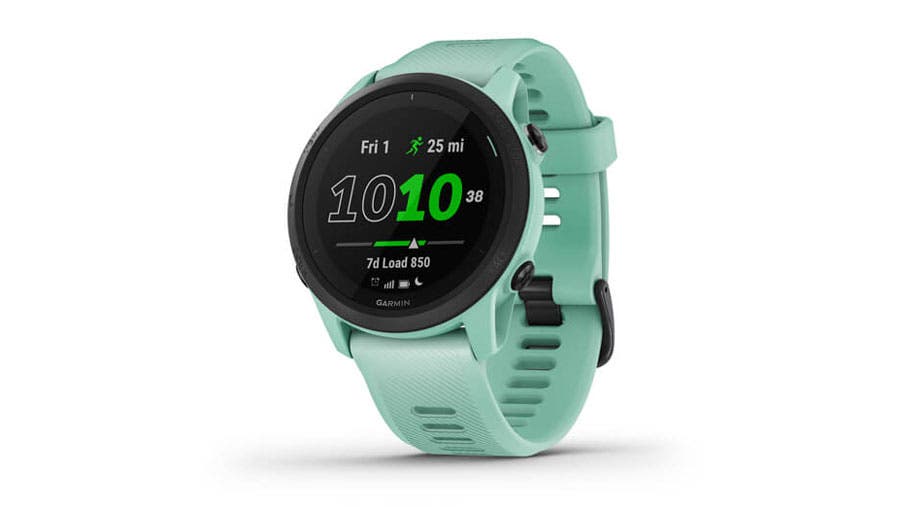
Data Depth – 4/5
Multisport Capabilities – 5/5
Connection – 2/5
Battery Life – 3/5
Accuracy – 4/5 (GPS), 4/5 (HR)
Lifestyle Capabilities – 3/5
It’s been a very long time since Garmin updated the 700 series of watches, and triathletes have been waiting with baited breath since the 735XT arrived so many years ago. The 700 series is meant to be a more “budget friendly” version of the 900 series that has basically everything you could possibly want in a multisport smartwatch—from all the necessary modes to data for days to apps to lifestyle functions to maps and back.
As such, the 745 is remarkably similar to the 945 that Garmin released at the end of last year, with a few minor exceptions: the 745 doesn’t have offline maps, it has slightly less storage, and the 745 is a little smaller. The biggest difference to me and probably most triathletes is the monstrous difference in battery life between the 745 (16 hours GPS training/7 days smartwatch) and the 945 (36 hours GPS/14 days smartwatch). While you’ll pretty much never think about plugging in the 945, the 745 does require a little attention when you’re working out three-to-four hours per day, six days per week. While it’s not as horrifying as the Apple Watch, it’s kind of an awkward battery life that can easily trip up your workout if you’re not careful.
Otherwise, this is a great watch with pretty much everything a triathlete would need, plus a bit more. If it wasn’t for the battery life and the fact that $500 is a lot for a smartwatch (bear in mind the 945 is only another $100), this should be a triathlete’s automatic go to. However, with cheaper watches having nearly the same amount of functions—minus music and some training stats/workout/recovery stuff—plus built-in running power, this doesn’t exactly kill the category on value.
Read Full Garmin Forerunner 745 Smartwatch Review Here
Fitbit Sense
$330, 47g, 12 hours training w/GPS, 6 days smartwatch, 40 x 40 x 12.35mm
amazon.com

Data Depth – 1/5
Multisport Capabilities – 2/5
Connection – 3/5
Battery Life – 3/5
Accuracy – 3/5 (GPS), 2/5 (HR)
Lifestyle Capabilities – 4/5
The latest touchscreen smartwatch from Fitbit is meant to have sensors and data for days (hence the name). Fitbit advertises everything from ECG functions (not yet available at time of writing), skin temperature, SpO2 levels, tons of sleep tracking metrics, sport tracking, menstrual tracking, and a ton more. The trick with this watch is wrangling all of that data into something meaningful and (though I’m not a fan of the word…) “actionable”—particularly for triathletes who are often wading, waist-deep in data already.
The Sense also has the same standard smartwatch “lifestyle” features that other models in the Fitbit lineup do pretty well: answering calls, checking notifications, music, and more. Along with a nice-looking touchscreen display and some very cool watchband options that are actually on par with Apple’s, this is an attractive watch for a lot of non-multisporters who want to stay connected and check on their biofeedback in a more general sense—plus the battery life blows the doors off the Apple Watch.
Unfortunately, for triathletes, this watch is a tough sell. The dearth of sensors do not add up to advice or metrics that are particularly helpful for someone who is already ostensibly healthy. By the time the alarm bells are going off (and it’s tough to tell when that is on the Sense), there’s a good chance you know your training isn’t going well anyway. The actual swim/bike/run/tri sport modes are definitely in the extremely basic category, as this GPS-based watch doesn’t have open-water swimming mode or any multisport mode either. Combined with an iffy touchscreen that is good for looking but not great for constant use, there are cheaper smartwatches on this list that might not be as pretty but will serve a triathlete in better ways.
Read Full Fitbit Sense Smartwatch Review Here *This review is exclusive for Active Pass Members*
Polar Vantage V2
$500, 52g, 40 hours training w/GPS, 7 days smartwatch mode, 46 x 46 x 13 mm
polar.com
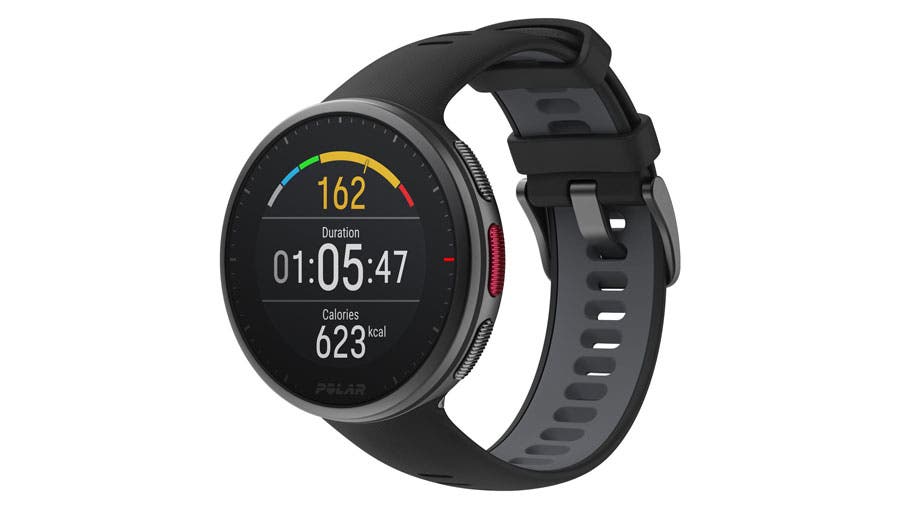
Data Depth – 5/5
Multisport Capabilities – 3/5
Connection – 2/5
Battery Life – 3/5
Accuracy – 3/5 (GPS), 3/5 (HR)
Lifestyle Capabilities – 2/5
This new update to one of the more analytical smartwatches available, the Vantage V, adds a few seemingly minor, but still super necessary features to a great touchscreen watch. For triathletes, this watch has the basic multisport modes (open-water/pool swimming, indoor/outdoor cycling with dynamics, running, and triathlon), but it’s still missing a few things that would be nice, like track mode for running and a preconfigurable multisport mode for bricks and swimrun. It does have a “Multisport” mode, but it’s very clunky and requires manual selection as you go.
The heart-rate monitor and GPS accuracy are both very good on land—though there are a few still better—but it struggles in the open water compared to others in this range. One of the biggest advantages of this watch is built-in running power that works well enough for most situations, and a host of recovery/coaching tools that could serve self-coached athletes very very well. The new updates to the Vantage include smartphone music controls (no onboard music or maps, however) and some very in-depth testing functions for running and cycling, while everyday “lifestyle” capabilities still lag far behind other brands.
Read Full Polar Vantage V2 Smartwatch Review Here *This review is exclusive for Active Pass Members*
Suunto 7
$500, 68g, 12 hours training w/GPS, 2 days smartwatch mode, 50 x 50 x 15.3 mm
amazon.com
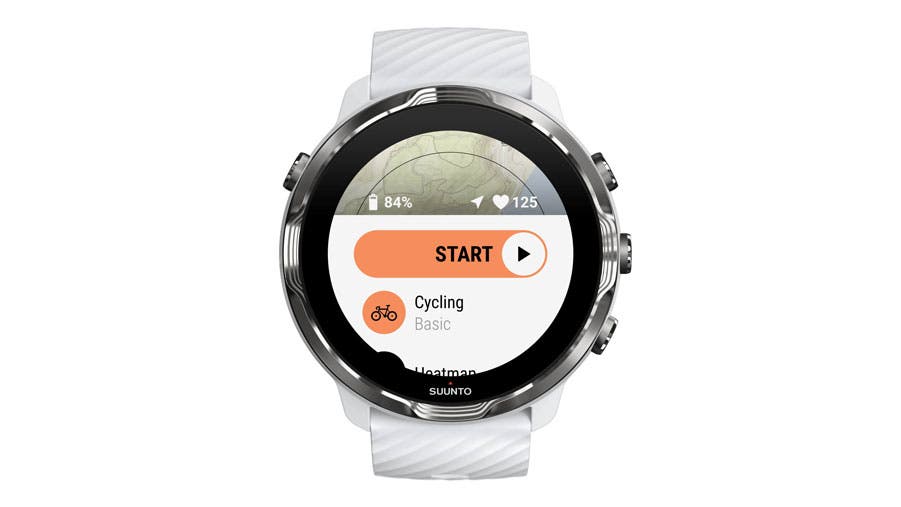
Data Depth – 3/5
Multisport Capabilities – 2/5
Connection – 3/5
Battery Life – 2/5
Accuracy – 4/5 (GPS), 2/5 (HR)
Lifestyle Capabilities – 4/5
While not ideal for triathletes who need something for serious training and racing, as the Suunto 7 doesn’t have a tri or multisport mode (it does have open-water swimming), there’s still plenty to love about a watch with a gorgeous color touchscreen, has onboard music and excellent offline maps, and works very well with the Wear OS platform. In terms of basic training and lifestyle use, we actually preferred the Suunto over the Apple Watch at times, and if you have an Android-based smartphone, this would be your solution. It’s a very large watch, but if you’re in the market for a burlier, outdoor-style watch, this is probably more appealing than the slim Apple Watch.
In terms of data and training, there’s only so much the Suunto 7 can do given that it’s oddly not compatible with external sensors—despite having Bluetooth connectivity. That’ll rule out cycling power or running power with a footpod. While the data is decent on the Suunto 7, you certainly won’t find any of the higher-end recovery metrics, workout suggestions, or performance stats that would help you if you were self coached and looking for some help from your smartwatch. That said, the heat mapping is a fantastic tool that can help you find new routes in unfamiliar places.